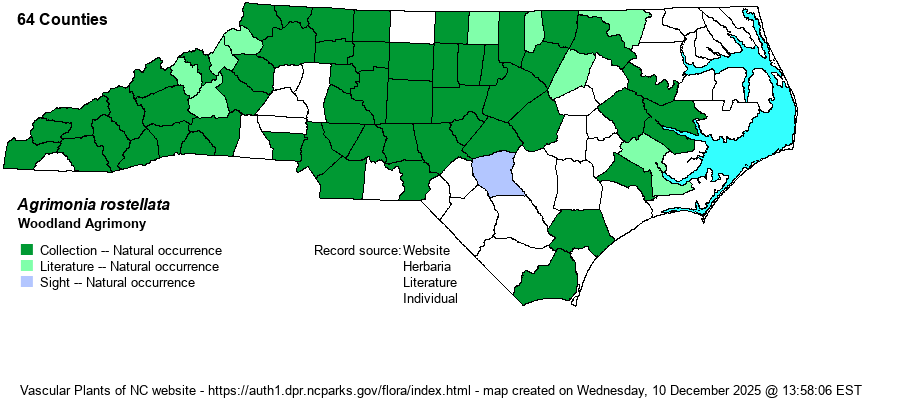| Author | Wallroth | |
| Distribution | Present over essentially all of the Piedmont and Mountains. Scattered over the western and central Coastal Plain, though probably absent from the northeastern counties.
This is a widespread species of the Eastern states, ranging from MA and IA south to northern FL and eastern TX. | |
| Abundance | Fairly common to frequent in the eastern and central Piedmont. Fairly common in the western Piedmont and Mountains, and probably under-collected in some areas. Rare to uncommon in the Coastal Plain, mainly in the northern half south to Beaufort, Pitt, and Johnston counties. The website editors suggest an S5 State Rank, as it is known from over half of the counties in the state and is fairly common in much of the western two-thirds of the state. | |
| Habitat | As with nearly all Agrimonia species, this prefers forests in uplands, however, it has a tendency to be found in rich, moist places, especially in high pH soils. It can occur in bottomland forests, rich to mesic upland forests, and also in openings and edges of forests. It is not normally associated with dry soil. | |
| Phenology | Blooms in July and August, and fruits from July to October. | |
| Identification | The genus Agrimonia has numerous species with distinctive leaves and flowering stalk, but the characters to separate many are quite technical, and biologists may have trouble keying them out. All have erect stems ranging in the vicinity of 3 feet tall, with alternate leaves that are distinctly pinnately compound, with small leaflets intermixed with much larger ones. Also, the inflorescence is a very long and slender spike-like raceme of tiny yellow flowers; these plants should be easily identified to genus level. In this species, the stem is rather stout and may reach up to 3 feet tall. This and several other species -- A. gryposepala, A. striata, and A. parviflora -- all have glistening glands along the stem and axis of the raceme. This species and A. gryposepala have these glands short stalked (use a hand lens), versus all glands sessile in the other two species. This species has the stipules at the bases of the leaves small and lanceolate to ovate, rarely more than 1/3-inch wide, as opposed to quite large and leaf-like, about 1/2-inch wide, and cordate at the base in A. gryposepala. Its large leaflets are rather obovate and wider near the tip, and about 2 inches long; and there is usually just one pair of small leaflets between larger ones. A. gryposepala, which also occurs in the mountains, is a larger species, reaching about 4 feet tall, but its leaflets are more elliptic (acute), with larger teeth, and often a second pair of small leaflets between the larger ones. Note that the equally robust A. parviflora has 11-15 large leaflets (that is, 5-7 pairs plus a large one at the end); all other NC species have only 9 or fewer large leaflets (4 pairs or fewer, plus the terminal one). This species may look quite a bit like A. pubescens at a glance, but that species is quite hairy on the stems and leaves, without glands, whereas this species is glandular on the stem and raceme axis. Squeeze the stem between your fingers if you are not sure, and this species should feel sticky. | |
| Taxonomic Comments | None
| |
| Other Common Name(s) | Beaked Agrimony | |
| State Rank | S4 [S5] | |
| Global Rank | G5 | |
| State Status | | |
| US Status | | |
| USACE-agcp | FAC link |
| USACE-emp | FACU link |

